Optimizing Anaerobic Co-Digestion Formula of Agro-Industrial Wastes in Semi-Continuous Regime
Abstract
:1. Introduction
2. Materials and Methods
2.1. Evaluated Raw Materials
2.2. Experiment Design and Equipment Employed
2.3. Analytical Methods
2.4. Statistical Treatment of Results
2.5. Evaluation of Substrate Removal Kinetic Models
3. Results and Discussion
3.1. Experiment Set Analysis
3.2. Parameter Evaluation Along the Process
3.3. Interactions of Parameters Measured in the Process
3.4. Substrate Removal Kinetics in Experimental Semi-Continuous Sets
4. Conclusions
Author Contributions
Funding
Data Availability Statement
Acknowledgments
Conflicts of Interest
References
- Ministerio para la Transición Ecológica y el Reto Demográfico (MITECO); Instituto para la Diversificación y el Ahorro de la Energía (IDAE). Plan Nacional Integrado de Energía y Clima 2021–2030; Spanish Gobern: Madrid, Spain, 2020; Available online: https://www.miteco.gob.es/content/dam/miteco/images/es/pnieccompleto_tcm30-508410.pdf (accessed on 10 January 2025).
- Feng, L.; Perschke, Y.M.L.; Fontaine, D.; Nikolausz, M.; Word, A.J.; da Rocha, U.N.; Corrêa, F.B.; Eriksen, J.; Sorensen, P.; Moller, H.B. Anaerobic digestion of co-ensiled cover crop and barley straw: Effect of co-ensiling ratios, manure addition and impact on microbial community structure. Ind. Crops Prod. 2020, 144, 112025. [Google Scholar] [CrossRef]
- Rani, P.; Pathak, V.V.; Bansal, M. Co-digestion of wheat straw and animal manure pretreated with calcium hydroxide for biomethane production: Kinetic study. Curr. Res. Green Sustain. Chem. 2021, 4, 100145. [Google Scholar] [CrossRef]
- Riau, V.; Burgos, L.; Camps, F.; Domingo, F.; Torellas, M.; Antón, A.; Bonmatí, A. Closing nutrient loops in a maize rotation. Catch crops to reduce nutrient leaching and increase biogas production by anaerobic co-digestion with dairy manure. Waste Manag. 2021, 126, 719–727. [Google Scholar] [CrossRef] [PubMed]
- Prabhu, A.V.; Raja, A.; Avinash, A.; Pugazhendhi, A. Parametric optimization of biogas potential in anaerobic co-digestion of biomass wastes. Fuel 2021, 288, 119574. [Google Scholar] [CrossRef]
- Mosquera, J.; Varela, L.; Santis, A.; Villamizar, S.; Acevedo, P.; Cabeza, I. Improving anaerobic co-digestion of different residual biomass sources readily available in Colombia by process parameters optimization. Biomass Bioenergy 2020, 142, 105790. [Google Scholar] [CrossRef]
- Somridhivej, B.; Boyd, C.E. An assessment of factors affecting the reliability of total alkalinity measurements. Aquaculture 2016, 459, 99–109. [Google Scholar] [CrossRef]
- Parralejo, A.I.; Royano, L.; Cabanillas, J.; González, J. Pretreatment and Nanoparticles as Catalysts for Biogas Production Reactions in Pepper Waste and Pig Manure. Catalysts 2023, 13, 1029. [Google Scholar] [CrossRef]
- Lorenzo, Y.; Obaya, M.C. La digestión anaerobia. Aspectos teóricos. Parte I” ICIDCA. Sobre Deriv. Caña Azúcar 2015, 39, 35–48. [Google Scholar]
- Dareioti, M.A.; Kornaros, M. Anaerobic mesophilic co-digestion of ensiled sorghum, cheese whey and liquid cow manure in a two-stage CSTR system: Effect of hydraulic retention time. Bioresour. Technol. 2015, 175, 553–562. [Google Scholar] [CrossRef]
- Cantale, C.; Petrazzuolo, F.; Correnti, A.; Farneti, A.; Felici, F.; Latini, A.; Galeffi, P. Triticale for Bioenergy Production, Florence “Sustainability of Well-Being International Forum”. 2015: Food for Sustainability and not just food, FlorenceSWIF2015. Agric. Agric. Sci. Procedia 2016, 8, 609–616. [Google Scholar] [CrossRef]
- Khatri, S.; Wu, S.; Kizito, S.; Zhang, W.; Li, J.; Dong, R. Synergistic effect of alkaline pretreatment and Fe dosing on batch anaerobic digestion of maize straw. Appl. Energy 2015, 158, 55–64. [Google Scholar] [CrossRef]
- Zhang, Y.; Caldwell, G.S.; Zealand, A.M.; Sallis, P.J. Anaerobic co-digestion of microalgae Chlorella vulgaris and potato processing waste: Effect of mixing ratio, waste type and substrate to inoculum ratio. Biochem. Eng. J. 2019, 143, 91–100. [Google Scholar] [CrossRef]
- Wang, W.; Jiang, Y.; Wang, S.; Zhang, Y.; Hu, Y.; Hu, Z.; Wu, G.; Zhan, X. Impact of total solids content on anaerobic co-digestion of pig manure and food waste: Insights into shifting of the methanogenic pathway. Waste Manag. 2020, 114, 96–106. [Google Scholar] [CrossRef]
- Hu, Y.; Kumar, M.; Wang, Z.; Zhan, X.; Stengel, D.B. Filamentous microalgae as an advantageous co-substrate for enhanced methane production and digestate dewaterability in anaerobic co-digestion of pig manure. Waste Manag. 2021, 119, 399–407. [Google Scholar] [CrossRef]
- Wang, Y.; Zhang, J.; Li, Y.; Jia, S.; Song, Y.; Sun, Y.; Zheng, Z.; Yu, Z.; Cui, Z.; Han, Y.; et al. Methane production from the co-digestion of pig manure and corn stover with the addition of cucumber residue: Role of the total solids content and feedstock-to-inoculum ratio. Bioresour. Technol. 2020, 306, 123172. [Google Scholar] [CrossRef]
- Pecar, D.; Gorsek, A. Kinetics of methane production during anaerobic digestion of chicken manure with sawdust and miscanthus. Biomass Bioenergy 2020, 143, 105820. [Google Scholar] [CrossRef]
- De la Lama, C.; Borja, R.; Rincón, B. Performance evaluation and substrate removal kinetics in the semi-continuous anaerobic digestion of thermally pretreated two phase olive pomace or “Alperujo”. Process. Saf. Environ. 2017, 105, 288–296. [Google Scholar] [CrossRef]
- APHA, American Public Health Association. Standard Methods for Examination of Water and Wastewater, 22nd ed.; American Public Health Association: Washington, DC, USA, 2012. [Google Scholar]
- Parralejo, A.I.; Royano, L.; González, J.; González, J.F. Small scale biogas production with animal excrement and agricultural residues. Ind. Crops Prod. 2019, 131, 307–314. [Google Scholar] [CrossRef]
- Norma UNE-EN 16948; Biocombustibles Sólidos, Determinación de Contenido total de C, H y N. AENOR, Asociación Española de NORmalización: Madrid, Spain, 2015.
- González, J.F.; Parralejo, A.I.; González, J.; Álvarez, A.; Sabio, E. Optimization of the production and quality of biogas in the anaerobic digestion of different types of biomass in a batch laboratory biodigester and pilot plant: Numerical modelling, kinetic study and hydrogen potential. Int. J. Hydrog. Energy 2022, 47, 39386–39403. [Google Scholar] [CrossRef]
- Zahan, Z.; Georgious, S.; Muster, T.H.; Othman, M.Z. Semi-continuous anaerobic co-digestion of chicken little with agricultural and food wastes: A case study on the effect of carbon/nitrogen ratio, substrates mixing ratio and organic loading. Bioresour. Technol. 2018, 270, 245–254. [Google Scholar] [CrossRef]
- Croce, S.; Wei, Q.; D’Imporzano, G.; Dong, R.; Adani, F. Anaerobic digestion of straw and corn stover: The effect of biological process optimization and pre-treatment on total bio-methane yield and energy performance. Biotechnol. Adv. 2016, 34, 1289–1304. [Google Scholar] [CrossRef] [PubMed]
- Hermann, C.; Kalita, N.; Wall, D.; Xia, A.; Murphy, J.D. Optimised biogas production from microalgae through co-digestion with carbon rich co-substrate. Bioresour. Technol. 2016, 214, 328–337. [Google Scholar] [CrossRef]
- Parralejo, A.I.; Royano, L.; Acevedo, M.; Cabanillas, J.; González, J. Study of the influence of pre-treatment in the grape waste biogas generation. Mod. Environ. Sci. Eng. 2019, 5, 207–214. [Google Scholar] [CrossRef]
- Rajagopal, R.; Torrijos, M.; Kumar, P.; Merohtra, I. Substrate removal kinetics in high-rate upflow anaerobic filters packed with low density polyethylene media treated high-strengh agro-food wastewater. J. Environ. Manag. 2013, 116, 101–106. [Google Scholar] [CrossRef]
- Isik, M.; Sponza, D.T. Substrate removal kinetic in an upflow anaerobic sludge blanket reactor decolorising simulated textile wastewater. Process Biochem. 2015, 40, 1189–1198. [Google Scholar] [CrossRef]
- Jijai, S.; Srisuwan, G.; O-thong, S.; Ismaile, N.; Siripatana, C. Effect of Granule Sizes on the Performance of Upflow Anaerobic Sludge Blanket (UASB) Reactors for Cassava Wastewater Treatment. Energy Procedia 2015, 79, 90–97. [Google Scholar]
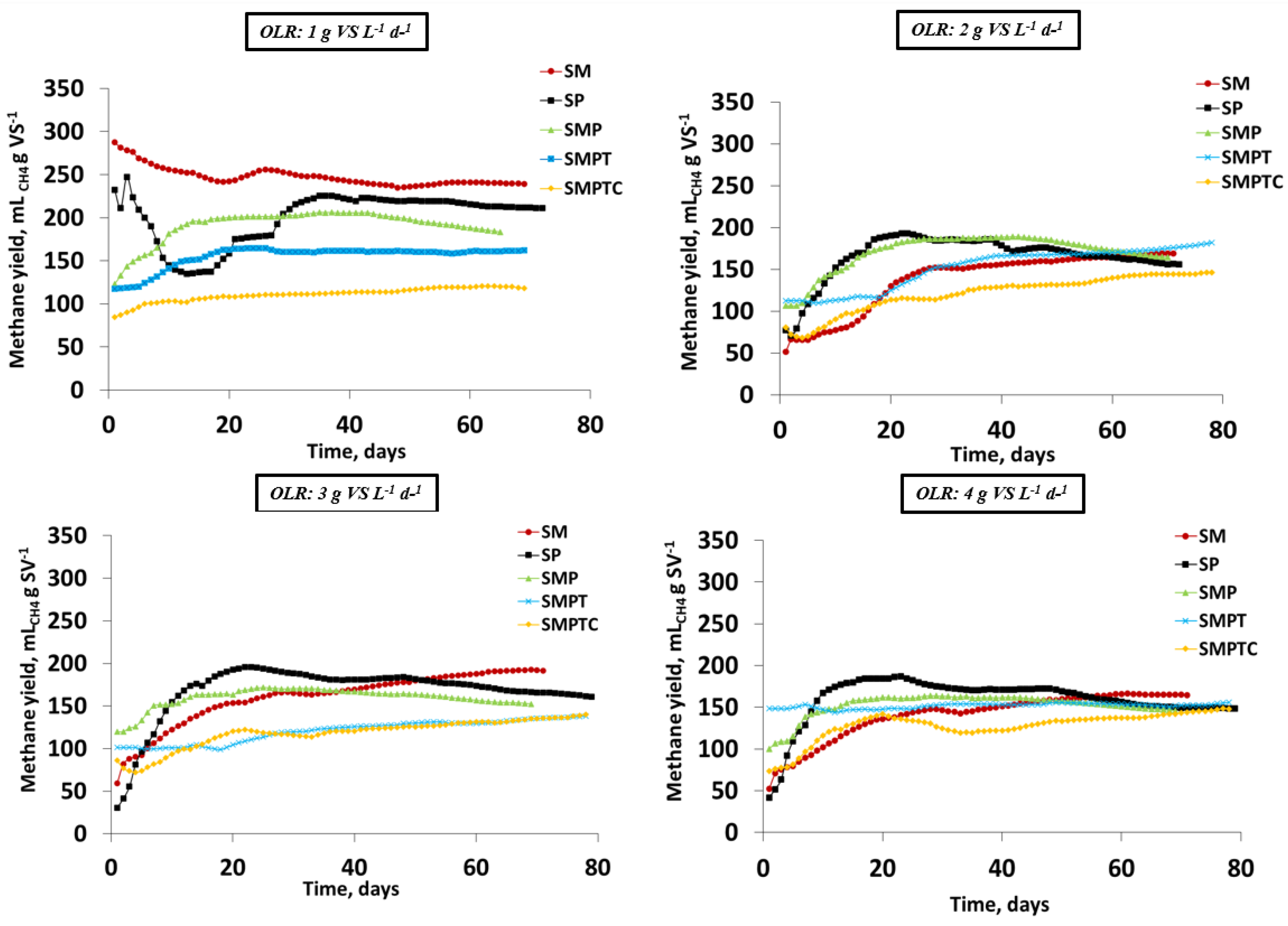

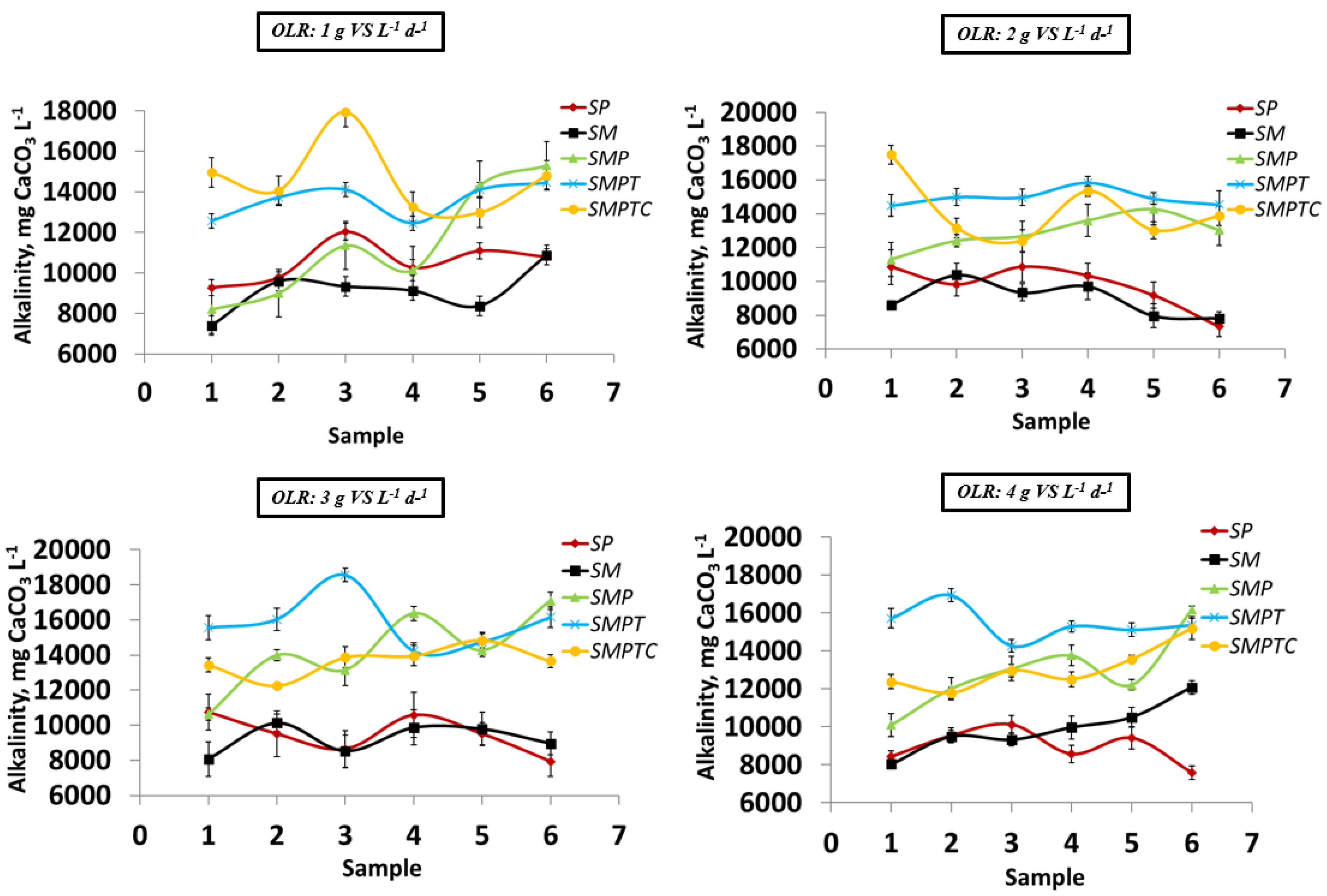
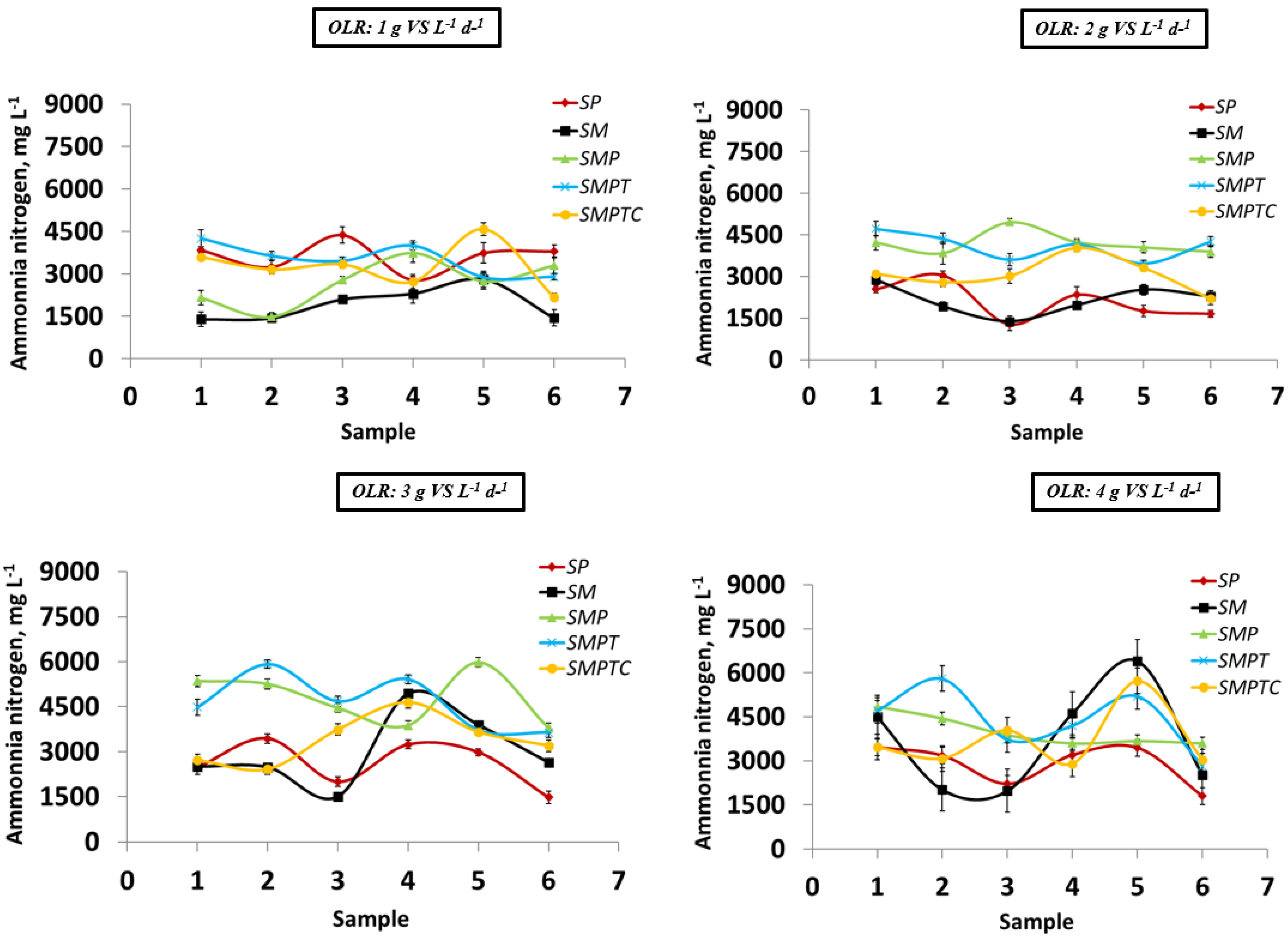
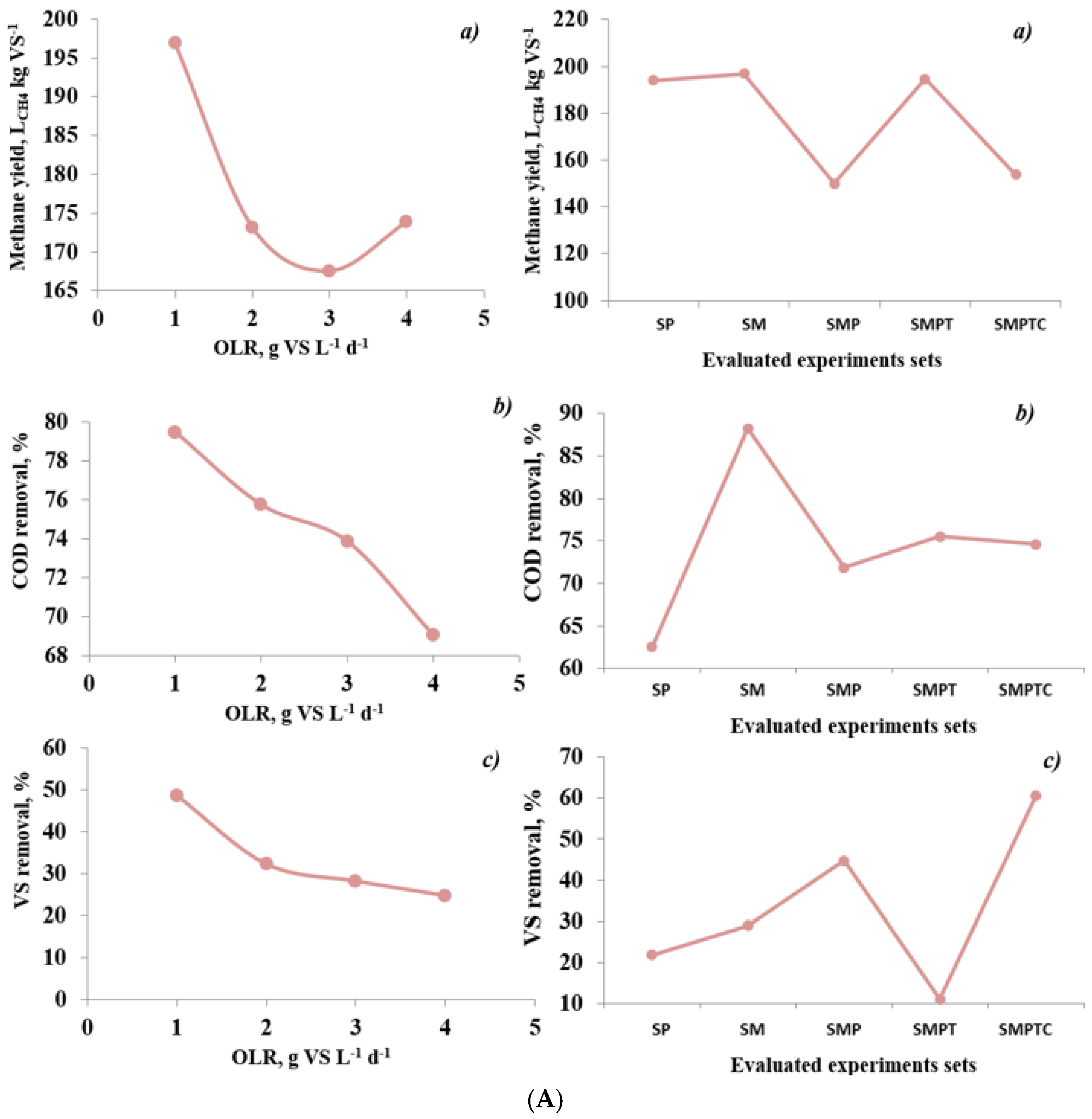

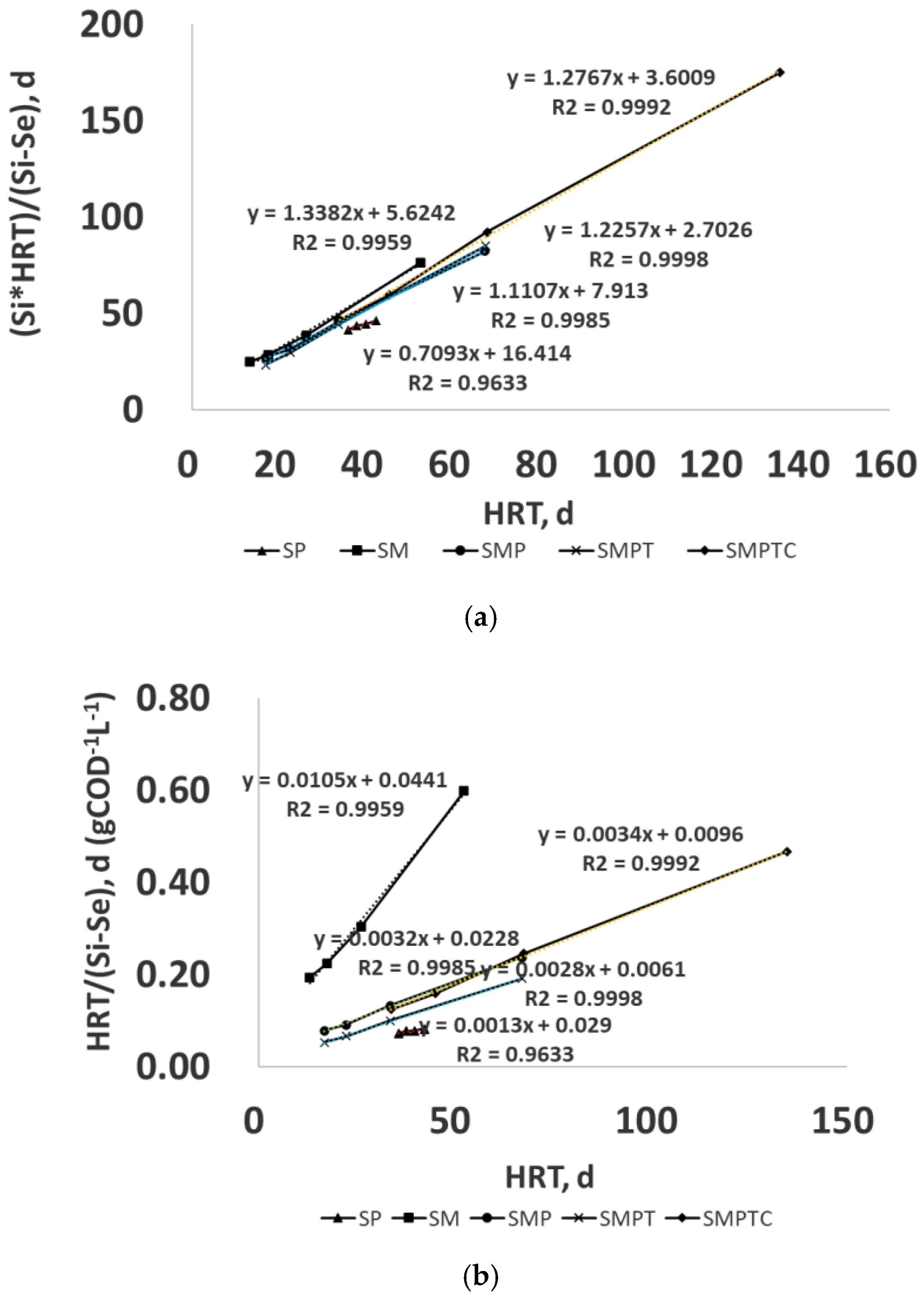
| Assays | Substrates (Proportion) | OLR, g VS L−1 d−1 | OLR, g COD L−1 d−1 | Time, d |
|---|---|---|---|---|
| SP1 | S and P (1:1) | 0.89 | 13 | 64 |
| SP2 | 1.81 | 25 | 64 | |
| SP3 | 2.68 | 38 | 64 | |
| SP4 | 3.55 | 50 | 64 | |
| SM1 | S and M (1:1) | 1.00 | 3 | 64 |
| SM2 | 2.00 | 6 | 64 | |
| SM3 | 3.00 | 9 | 64 | |
| SM4 | 4.00 | 11 | 64 | |
| SMP1 | S, M and P (1:0.5:1) | 1.14 | 8 | 64 |
| SMP2 | 2.33 | 15 | 64 | |
| SMP3 | 3.44 | 23 | 64 | |
| SMP4 | 4.59 | 31 | 64 | |
| SMPT1 | S, M, P and T (1:1:1:1) | 0.98 | 10 | 64 |
| SMPT2 | 1.94 | 20 | 64 | |
| SMPT3 | 2.91 | 30 | 64 | |
| SMPT4 | 4.00 | 39 | 64 | |
| SMPTC1 | S, M, P, T and C (1:1:1:1:1) | 1.00 | 8 | 64 |
| SMPTC2 | 2.00 | 17 | 64 | |
| SMPTC3 | 3.00 | 25 | 64 | |
| SMPTC4 | 4.00 | 33 | 64 |
| Parameter | S | M | P | T | C |
|---|---|---|---|---|---|
| pH | 3.64 ± 0.02 | 7.64 ± 0.01 | 7.68 ± 0.12 | 4.71 ± 0.01 | 5.80 ± 0.03 |
| VS, % | 93.10 ± 0.20 | 65.00 ± 0.11 | 0.43 ± 0.05 | 93.30 ± 0.20 | 94.76 ± 0.12 |
| C/N ratio a | 65.78 ± 0.24 | 6.02 ± 0.08 | 6.41 ± 0.03 | 47.50 ± 0.10 | 64.18 ± 0.08 |
| Proteins, % a | 4.06 ± 0.02 | 41.63 ± 0.06 | 14.06 ± 0.18 | 5.69 ± 0.06 | 6.75 ± 0.05 |
| Carbohidrates, % a | 93.84 ± 0.08 | 55.77 ± 0.16 | 85.32 ± 0.25 | 92.89 ± 0.10 | 92.65 ± 0.12 |
| Lipids, % a | 2.10 ± 0.16 | 2.60 ± 0.01 | 0.62 ± 0.03 | 1.42 ± 0.21 | 0.60 ± 0.10 |
| Alkalinity, mg L−1 | - | 2616 ± 24 | 10,096 ± 102 | - | - |
| COD, mg O2 L−1 | 936,000 ± 3100 | 1,500,000 ± 50,000 | 11,000 ± 201 | 49,600 ± 16,000 | 988,000 ± 10,100 |
| VFA, mg L−1 | - | 319 ± 18 | 4800 ± 411 | - | - |
| N-NH4, mg L−1 | <30 | 214 ± 26 | 3850 ± 100 | 30 ± 5 | 140 ± 10 |
| Methane yield b, LCH4 kg VS−1 | 419 ± 62 | 306 ± 38 | 102 ± 23 | 373 ± 12 | 345 ± 73 |
| Na, ppm a | 600 ± 48 | 1368 ± 110 | 651 ± 12 | 212 ± 53 | 347 ± 18 |
| Mg, ppm a | 2657 ± 211 | 2074 ± 408 | 211 ± 41 | 1947 ± 12 | 1844 ± 253 |
| Fe, ppm a | 744 ± 51 | 2201 ± 84 | 25 ± 4 | 702 ± 26 | 1675 ± 360 |
| Ca, ppm a | 2853 ± 128 | 29,415 ± 2051 | 485 ± 17 | 4276 ± 215 | 3925 ± 281 |
| Cd, ppm a | <2 | <2 | <2 | 32 ± 5 | <2 |
| Cu, ppm a | <5 | 22 ± 4 | 7 ± 2 | 26 ± 3 | <5 |
| Experiment | X1, mLCH4 L−1 | X2, LCH4 kg VS−1 | t, Days | X3, LCH4 kg VS−1 |
|---|---|---|---|---|
| SP1 | 210.20 ± 3.85 | 236.13 ± 3.85 | 55 | 195.09 ± 25.19 |
| SP2 | 294.62 ± 3.74 | 162.88 ± 1.87 | 68 | |
| SP3 | 438.43 ± 6.46 | 163.92 ± 2.15 | 77 | |
| SP4 | 771.28 ± 8.02 | 217.43 ± 2.00 | 59 | |
| SM1 | 231.36 ± 6.79 | 231.36 ± 7.63 | 71 | 197.69 ± 37.39 |
| SM2 | 393.22 ± 4.99 | 196.61 ± 2.76 | 84 | |
| SM3 | 576.91 ± 5.92 | 192.30 ± 2.21 | 90 | |
| SM4 | 681.94 ± 8.70 | 170.49 ± 2.45 | 66 | |
| SMP1 | 197.17 ± 3.50 | 173.03 ± 3.07 | 57 | 149.80 ± 16.39 |
| SMP2 | 333.31 ± 7.51 | 142.99 ± 3.22 | 58 | |
| SMP3 | 463.92 ± 6.51 | 135.06 ± 1.90 | 65 | |
| SMP4 | 679.60 ± 8.60 | 148.13 ± 1.90 | 64 | |
| SMPT1 | 202.50 ± 2.55 | 206.99 ± 2.61 | 83 | 195.76 ± 14.36 |
| SMPT2 | 405.84 ± 5.32 | 209.34 ± 2.74 | 91 | |
| SMPT3 | 534.03 ± 5.86 | 183.70 ± 2.02 | 92 | |
| SMPT4 | 731.94 ± 6.78 | 183.02 ± 1.69 | 96 | |
| SMPTC1 | 139.75 ± 2.45 | 139.75 ± 2.45 | 49 | 157.15 ± 12.87 |
| SMPTC2 | 312.47 ± 3.19 | 156.24 ± 1.60 | 119 | |
| SMPTC3 | 509.69 ± 4.49 | 169.90 ± 1.50 | 93 | |
| SMPTC4 | 650.89 ± 5.82 | 162.72 ± 1.45 | 93 |
| Experiment | VS, % | COD, % | VFA, mg L−1 | Ratio C/N | N-NH4, mg L−1 | Alkalinity, mg CaCO3 L−1 |
|---|---|---|---|---|---|---|
| SP1 | 2.09 ± 0.88 a | 40,083 ± 18,034 | 2134 ± 641 | 10.11 ± 1.73 | 3630 ± 550 b | 10,538 ± 987 |
| SP2 | 4.33 ± 1.16 b | 41,417 ± 9932 | 1504 ± 312 | 20.38 ± 4.76 | 2103 ± 651 a | 9720 ± 675 |
| SP3 | 5.30 ± 1.36 b | 49,667 ± 12,828 | 1275 ± 391 | 16.99 ± 4.34 | 2603 ± 760 a | 9483 ± 797 |
| SP4 | 5.39 ± 1.39 b | 60,083 ± 13,559 | 1597 ± 875 | 21.23 ± 5.38 | 2883 ± 699 ab | 8949 ± 910 |
| SM1 | 2.99 ± 0.67 | 49,583 ± 21,080 | 1898 ± 634 | 11.21 ± 4.37 | 1913 ± 580 | 9112 ± 1175 |
| SM2 | 3.64 ± 0.54 | 60,167 ± 17,896 | 2399 ± 735 | 11.93 ± 5.21 | 2157 ± 523 | 8966 ± 1015 |
| SM3 | 4.39 ± 0.47 | 78,167 ± 44,646 | 2514 ± 869 | 11.75 ± 4.77 | 2993 ± 1223 | 9223 ± 830 |
| SM4 | 4.47 ± 0.80 | 77,917 ± 36,375 | 2747 ± 1005 | 10.97 ± 4.85 | 3673 ± 1786 | 9900 ± 1348 |
| SMP1 | 4.18 ± 1.40 | 67,250 ± 22,026 a | 2049 ± 425 | 10.58 ± 1.78 | 2701 ± 755 a | 11,389 ± 2878 |
| SMP2 | 5.29 ± 1.01 | 103,667 ± 11,479 b | 1679 ± 257 | 10.26 ± 1.93 | 4202 ± 1035 b | 12,879 ± 1031 |
| SMP3 | 5.35 ± 0.68 | 119,167 ± 43,792 bc | 2057 ± 334 | 10.51 ± 2.02 | 4790 ± 777 b | 14,250 ± 2320 |
| SMP4 | 5.11 ± 0.50 | 126,750 ± 13,758 c | 1712 ± 843 | 10.19 ± 1.72 | 4007 ± 1279 b | 12,890 ± 2350 |
| SMPT1 | 6.65 ± 1.79 a | 92,700 ± 18,368 a | 4983 ± 1468 | 12.67 ± 0.85 | 3523 ± 564 | 13,573 ± 852 a |
| SMPT2 | 6.48 ± 1.06 ab | 108,333 ± 16,241 ab | 4979 ± 2199 | 12.56 ± 0.46 | 4092 ± 498 | 14,949 ± 484 b |
| SMPT3 | 7.59 ± 1.06 b | 109,167 ± 17,848 ab | 4194 ± 1413 | 12.71 ± 0.80 | 4643 ± 908 | 15,878 ± 1522 b |
| SMPT4 | 7.66 ± 1.05 b | 124,250 ± 17,581 b | 5143 ± 716 | 12.97 ± 0.78 | 4410 ± 1068 | 15,452 ± 872 b |
| SMPTC1 | 5.29 ± 1.89 | 86,250 ± 28,656 | 3439 ± 1976 | 13.22 ± 1.47 | 3260 ± 694 | 14,664 ± 1786 |
| SMPTC2 | 5.55 ± 1.88 | 87,008 ± 21,119 | 3574 ± 1545 | 12.92 ± 1.49 | 3080 ± 606 | 14,213 ± 1893 |
| SMPTC3 | 5.39 ± 1.97 | 91,416 ± 11,254 | 3891 ± 1337 | 12.83 ± 1.11 | 3397 ± 798 | 13,670 ± 845 |
| SMPTC4 | 5.81 ± 1.00 | 107,083 ± 13,945 | 2871 ± 805 | 11.90 ± 1.56 | 3707 ± 1069 | 13,066 ± 1204 |
| Set/Substrates | OLR, g VS L−1 d−1 | HRT, d | ks, g COD g VS−1 d−1 | Reference | |
| Grau Second-Order Multicomponent | SP | 0.89–3.55 | 13–52 | 4 | In this work |
| SM | 1.00–4.00 | 36–42 | 39 | In this work | |
| SMP | 1.14–4.59 | 17–67 | 10 | In this work | |
| SMPT | 0.98–4.00 | 17–67 | 29 | In this work | |
| SMPTC | 1.00–4.00 | 34–135 | 20 | In this work | |
| Cassava wastewater | 3.76–18.80 * | 1–5 | 1.55–8.23 | [29] | |
| Fruit canning | 9–11.6 * | 0.48–2.25 | 5 | [27] | |
| Cheese dairy wastewater | 23–40 * | 1.3–6.2 | 1.93 | [27] | |
| “Alperujo” | 2–7 | 47–116 | 0.25 | [18] | |
| Textile wastewater | 1.0–15.8 | 0.25–4.17 | 0.337 | [28] | |
| Set/Substrates | OLR, g VS L−1 d−1 | HRT, d | kB, g COD L−1 d−1 | Reference | |
| Modified Stover–Kicannon | SP | 0.89–3.55 | 13–52 | 6 | In this work |
| SM | 1.00–4.00 | 36–42 | 135 | In this work | |
| SMP | 1.14–4.59 | 17–67 | 49 | In this work | |
| SMPT | 0.98–4.00 | 17–67 | 204 | In this work | |
| SMPTC | 1.00–4.00 | 34–135 | 133 | In this work | |
| Cassava wastewater | 3.76–18.80 * | 1–5 | 6.11–48.24 | [29] | |
| Fruit canning | 9–11.6 * | 0.48–2.25 | 109.7 | [27] | |
| Cheese dairy wastewater | 23–40 * | 1.3–6.2 | 49.7 | [27] | |
| “Alperujo” | 2–7 | 47–116 | 11.15 | [18] | |
| Textile wastewater | 1.0–15.8 | 0.25–4.17 | 8.2 | [28] |
Disclaimer/Publisher’s Note: The statements, opinions and data contained in all publications are solely those of the individual author(s) and contributor(s) and not of MDPI and/or the editor(s). MDPI and/or the editor(s) disclaim responsibility for any injury to people or property resulting from any ideas, methods, instructions or products referred to in the content. |
© 2025 by the authors. Licensee MDPI, Basel, Switzerland. This article is an open access article distributed under the terms and conditions of the Creative Commons Attribution (CC BY) license (https://creativecommons.org/licenses/by/4.0/).
Share and Cite
Parralejo, A.I.; González, J.; Royano, L.; González, J.F. Optimizing Anaerobic Co-Digestion Formula of Agro-Industrial Wastes in Semi-Continuous Regime. Energies 2025, 18, 1689. https://doi.org/10.3390/en18071689
Parralejo AI, González J, Royano L, González JF. Optimizing Anaerobic Co-Digestion Formula of Agro-Industrial Wastes in Semi-Continuous Regime. Energies. 2025; 18(7):1689. https://doi.org/10.3390/en18071689
Chicago/Turabian StyleParralejo, Ana I., Jerónimo González, Luis Royano, and Juan F. González. 2025. "Optimizing Anaerobic Co-Digestion Formula of Agro-Industrial Wastes in Semi-Continuous Regime" Energies 18, no. 7: 1689. https://doi.org/10.3390/en18071689
APA StyleParralejo, A. I., González, J., Royano, L., & González, J. F. (2025). Optimizing Anaerobic Co-Digestion Formula of Agro-Industrial Wastes in Semi-Continuous Regime. Energies, 18(7), 1689. https://doi.org/10.3390/en18071689








